Text
Accessible base, accessible base! A great opportunity to have it be a portal to a very calm woods in the middle of nowhere. There's a bunch of potential here. For example:
Not all is actually well, because there's a hidden mystery here, and signs that staying too long, or straying too far, ends up attracting strange, dangerous beings or even stranger friendly people, but they never seem to appear in the first long rest in a day/week.
Should the party choose, they can investigate further and further information about the place and its history. If they don't, that's fine too
Eventually, the campaign reaches a point.
A point where they might stumble across it in person, or where they know enough about the place, or enough about the campaign, to have everything click together.
That their strange, humble abode for these many months/years, is/was the territory of the BBEG and their people, and is the site of their final battle...
I really like the campsite in bg3 and I want to figure out a way to use it in d&d.
Maybe it's just because I've been on an irl camping kick, but I think its adorable (everyone has their own little tents and decorations) and it also solves the issue of characters that are part of the campaign but not actively in the party.
Obviously some mechanics that make sense in a video game don't translate to tabletop and vice versa, but it would be great if a player misses a session and you could just say they went back to the camp for something.
Yeah, it's still a little handwave-y but it feels more natural than some other options, and the concept of having a base camp isn't a new thing. Plus you can have some more passive down-time activity stuff happening at camp. Maybe the party comes back to camp and there's a message waiting for them. Etc
I also don't track encumbrance or hit dice, just to reduce some complexity with the rules and keep things fun for new players without having a million things to keep track of. But Camp is an easy explanation for storage (without having to immediately give a lvl 1 party a bag of holding) and I like the idea that if you long rest at camp you get all your hit points/hit dice back because there's someone there managing the supplies and cooking etc vs if you're sleeping in the field you don't.
I think the concept could also scale up with the party gaining a house or stronghold etc. Cause I feel like sometimes that happens but the party ends up not actually going to their house etc because they're going other places. But the concept of teleportation/extra dimensional spaces already exists in d&d, so why not apply it to living space? I also like the idea of having some more levels between sleeping on the ground and getting attacked by dire wolves nightly and perfectly portable and defensible mordankeinens magnificent mansion.
474 notes
·
View notes
Text
Dungeon Masters working together to make the ultimate new player pamphlet to get people into the game! This would be game changing (hehe), let's get it done!
Calling Tumblr DMs
Inspired by @thydungeonguy 's recent posts about teaching new players to play d&d I think I want to put together a thinktank and develop a sort of .... player pamphlet?
Something that contains the basics on mechanics yes but also an intro on the "unspoken oral tradition" of d&d play that *I'm* very fond of but isn't communicated at all in the books. Ideally it'd be zine sized, something you could print out, fold, staple, and then hand out a few copies during session 0 or whatever for people to take home and read, rather than having to borrow or gods forbid buy a players handbook and wander around the youtube tutorial rabbithole and STILL come away with questions.
I think I'm going to form a discord chat for this, shoot me a DM (ha) if you'd like an invite. Also if you're not a dungeonmaster or don't feel like joining in, maybe spread this around? The more help I can get brainstorming the more I'll
114 notes
·
View notes
Text
A really great mechanic to simulate research in our games. A method of exposition, and insight into worldbuilding through perspective.
Some professional insight from a historian into some banging great ways to deliver information in a way which feels both natural and wondrous
Serves as a really great base to shape towards situation, setting, and method of delivery!
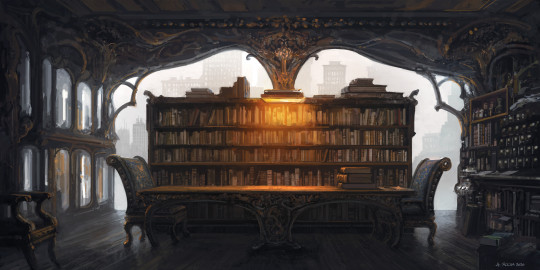
Homebrew Mechanic: Meaningful Research
Being careful about when you deliver information to your party is one of the most difficult challenges a dungeonmaster may face, a balancing act that we constantly have to tweak as it affects the pacing of our campaigns.
That said, unlike a novel or movie or videogame where the writers can carefully mete out exposition at just the right time, we dungeonmasters have to deal with the fact that at any time (though usually not without prompting) our players are going to want answers about what's ACTUALLY going on, and they're going to take steps to find out.
To that end I'm going to offer up a few solutions to a problem I've seen pop up time and time again, where the heroes have gone to all the trouble to get themselves into a great repository of knowledge and end up rolling what seems like endless knowledge checks to find out what they probably already know. This has been largely inspired by my own experience but may have been influenced by watching what felt like several episodes worth of the critical role gang hitting the books and getting nothing in return.
I've got a whole write up on loredumps, and the best way to dripfeed information to the party, but this post is specifically for the point where a party has gained access to a supposed repository of lore and are then left twiddling their thumbs while the dm decides how much of the metaplot they're going to parcel out.
When the party gets to the library you need to ask yourself: Is the information there to be found?
No, I don't want them to know yet: Welcome them into the library and then save everyone some time by saying that after a few days of searching it’s become obvious the answers they seek aren’t here. Most vitally, you then either need to give them a new lead on where the information might be found, or present the development of another plot thread (new or old) so they can jump on something else without losing momentum.
No, I want them to have to work for it: your players have suddenly given you a free “insert plothook here” opportunity. Send them in whichever direction you like, so long as they have to overcome great challenge to get there. This is technically just kicking the can down the road, but you can use that time to have important plot/character beats happen.
Yes, but I don’t want to give away the whole picture just yet: The great thing about libraries is that they’re full of books, which are written by people, who are famously bad at keeping their facts straight. Today we live in a world of objective or at least peer reviewed information but the facts in any texts your party are going to stumble across are going to be distorted by bias. This gives you the chance to give them the awnsers they want mixed in with a bunch of red herrings and misdirections. ( See the section below for ideas)
Yes, they just need to dig for it: This is the option to pick if you're willing to give your party information upfront while at the same time making it SEEM like they're overcoming the odds . Consider having an encounter, or using my minigame system to represent their efforts at looking for needles in the lithographic haystack. Failure at this system results in one of the previous two options ( mixed information, or the need to go elsewhere), where as success gets them the info dump they so clearly crave.
The Art of obscuring knowledge AKA Plato’s allegory of the cave, but in reverse
One of the handiest tools in learning to deliver the right information at the right time is a sort of “slow release exposition” where you wrap a fragment lore the party vitally needs to know in a coating of irrelevant information, which forces them to conjecture on possibilities and draw their own conclusions. Once they have two or more pieces on the same subject they can begin to compare and contrast, forming an understanding that is merely the shadow of the truth but strong enough to operate off of.
As someone who majored in history let me share some of my favourite ways I’ve had to dig for information, in the hopes that you’ll be able to use it to function your players.
A highly personal record in the relevant information is interpreted through a personal lens to the point where they can only see the information in question
Important information cameos in the background of an unrelated historical account
The information can only be inferred from dry as hell accounts or census information. Cross reference with accounts of major historical events to get a better picture, but everything we need to know has been flattened into datapoints useful to the bureaucracy and needs to be re-extrapolated.
The original work was lost, and we only have this work alluding to it. Bonus points if the existent work is notably parodying the original, or is an attempt to discredit it.
Part of a larger chain of correspondence, referring to something the writers both experienced first hand and so had no reason to describe in detail.
The storage medium (scroll, tablet, arcane data crystal) is damaged in some way, leading to only bits of information being known.
Original witnesses Didn’t have the words to describe the thing or events in question and so used references from their own environment and culture. Alternatively, they had specific words but those have been bastardized by rough translations.
Tremendously based towards a historical figure/ideology/religion to the point that all facts in the piece are questionable. Bonus points if its part of a treatise on an observably untrue fact IE the flatness of earth
453 notes
·
View notes
Text
This just upturned an entire part of my DnD worldbuilding philosophy
Turn needs to opportunities and figure out what those opportunities are
Turn those opportunities into ‘secrets’ (as per the supplement Return of the Lazy Dungeon Master) and you get really easy, deep and complex worldbuilding to show your players and have them experience. To explain the existence of monsters close to the city they could find out that its a wandering warband, or that political issues prevent the citizens from being able to evacuate anywhere else, or the such
It’s like a bridge that converts problems to content. Neat!
i think one of the reasons i get mildly annoyed about worldbuilding threads that are 200 tweets of why you should care about where blue dye comes from in your world before saying someone is wearing blue is that so few of them go up to the second level of "and that should impact your characters somehow" - i don't care that blue dye comes from pressing berries that only grow in one kingdom a thousand miles away if people are casually wearing blue
28K notes
·
View notes
Text
An excellent principle that accomplishes a triple whammy of making things more fun for everyone, putting less work on the DM, and creating a much more satisfying and natural narrative over time!
Over time, especially at the higher tiers of DnD (and perhaps other TTRPGS), you come to learn that encounter design should have room for chaos to make things unpredictable and interesting.
Let your players surprise you
Make that boss that much more difficult! Add in some interactable elements, push em here, rush them there!
If everyone plays optimally to maximise their damage and survival, do they win? You could calculate it all down but honestly, you really don't need to, and in fact, you might not really even want to as a principle, because the mystery of how it all plays out is just that much more interesting, natural and 'real'!
A great follow-up principle to keep in mind is that, when keeping things chaotic, it is better to have random/general encounters vary in difficulty and/or err on the side of easier, and have important 'boss' battles err on the side of higher difficulty.
A higher difficulty all the time is exhausting and demoralising, but a higher difficulty in the right moments/encounters leads to players needing to innovate and coordinate, and that is where combat's most epic memories are made!
Got any tips to add on this? Or perhaps any similar tips like the original post?
The problem-problem in TTRPGs
A problem I come up against when playing some TTRPGs is that I don't want the same person to both make and solve problems. I find it makes an otherwise fun game idea very narratively unsatisfying.
This is sometimes called the Czege principle for Paul Czege who articulated this problem: "When one person is the author of both the character's adversity and its resolution, play isn't fun." In a GMed game, the GM can set a problem (this can be social, a puzzle, combat, an obstacle of some sort) and then the player characters resolve the problem. Or, in some GMless games, a prompt provides the problem - such as pulling card prompts in Quiet Year - and the players decide on the solution. Similarly, having some randomness in the outcome like dice can help justify why solving the problem suceeded or failed.
Brendan Lee Mulligan had an excellent statement on 'railroading' which I think applies here - he said players want a story with twists and turns but character want to solve a problem as quickly as possible. So the GM's job (which we can extrapolate to the game's job too) is to provide the twists and turns that make the story interesting and help players feel justified in their character choosing the most interesting option.
youtube
But I think some games want to let everyone do everything and ask the players to both come up with problems and solve them, and i find that tends to lead to obstacles with little weight behind them.
If I'm creating the problem, I'll usually have some idea of a solution, at which point it doesn't really feel like a real problem any more if i solve it. And, if I'm one of the people who can solve the problem, I'm also inclined to make the initial problem easy to solve. Even if i resist that urge to solve it myself, i find it becomes harder for other players to escalate the problem - because who wants to/feels justified in making things worse when you also want your characters to suceed? So the problem gets solved right away. Which is boring.
A good example of treading the line is Belonging outside Belonging- Dream Askew and Dream Apart have the token system to throttle how fast you can solve problems. But if hacks alter the token economy, it can feel superfluous, like you are just making problems to solve them again.
I've found it also in some GMed games that try and alter the flow of narrative by giving a lot of control to players, which can be fun but can also make it difficult to know who has final say on resolving problems.
I think this problem-problem is perhaps a sign for game designers to remember to think about why you are using a certain system and how it fits with the types of narrative cycles you want to encourage. Who is creating and who is solving the problems in your game? Is there support in the mechanics for them to justify making things harder? Will the outcome feel earnt, or will players fall back on the easy option, and how can you encourage interesting choices and further trouble?
#gm tips#gm advice#dm advice#dm tips#dungeon master tips#dnd tips#dnd resources#dnd#ttrpg#ttrpgs#dungeons and dragons tips
659 notes
·
View notes
Text
I love OTGW and I love 'translating' aspects of other things into a better understanding of otherwise unrelated things, this one is right up my alley! Great advice all around
What can OVER THE GARDEN WALL teach us about creating adventures? A whole lot, it turns out! Let's break down the structure so we can use it for our own designs.

First off, a link to the post:
While the narrative of a television show doesn't translate perfectly to RPGs, each episode of OTGW could be easily reworked to a great adventure.
If we deconstruct them, we end up with four foundational pillars:
A familiar, recognizable situation.
A mystery, question, or strange unexplained circumstance.
A twist on expectations.
A non-reliance on violence.
A FAMILIAR, RECOGNIZABLE SITUATION. If we start with something the players can easily grasp, we can leverage all the baggage and expectations that comes with it to our advantage.
A MYSTERY, QUESTION, OR STRANGE UNEXPLAINED CIRCUMSTANCE. Players are drawn in when there's a known unknown that they can try and solve.
A TWIST ON EXPECTATIONS. This is where you bring your own special sauce to the idea and make it truly yours. Twist the expectations when you're figuring out the answers to the mysteries.
A NON-RELIANCE ON VIOLENCE. Don't conceive of specific solutions to the adventure. But ESPECIALLY avoid violence being the only way to solve the scenario.
The advice here works for all types of adventure, not just for the setting of OTGW or D&D. The post goes into more detail and provides examples. A bonus section talks about how to bring the vibes of OTGW to your game. Check it out!
#gming#over the garden wall#gm advice#rpg#ttrpg#indie ttrpg#dm tips#dm advice#dungeons and dragons tips#dungeon master tips#dungeon master advice
188 notes
·
View notes
Photo
This is a really rich resources of inspiration and advice! Might resort to something like this as things develop!
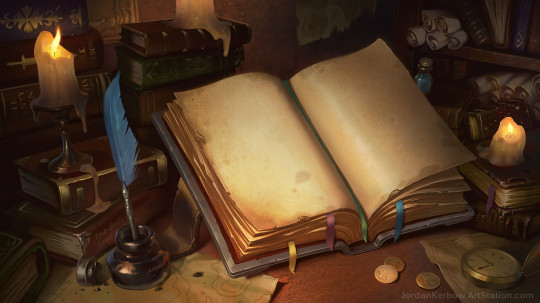
The Daily Adventure Prompts Masterpost
After several years of running this blog, it’s become more and more evident that I need some central reference where people can access all my different DM advice posts, important tags, and ongoing series. Sharing my ideas with people and helping to improve the art and craft of being a dungeonmaster was always the point of DAP after all, and its of no help to anyone if the answers to important questions are buried under a hundred or more pages of my rambling.
To that end, I present this post as an ever expanding catalogue of my thoughts. Something that you can page through at your leisure in hopes some of my hardwon lessons will be of use to you.
Keep reading
372 notes
·
View notes
Text
Obsidian is a LIFESAVER for TTRPGs
This is a heads up for other DMs or even dedicated players, especially for those interested in detailed, interconnected notes that need to be organised.
Try out Obsidian. It's a stellar note-taking application/program that HAS FULLY SUPPORTED MODS (plugins) in the app itself
This isn't an advert or something, the app is just exactly what I've been wanting for a long time, that I never really acknowledged until someone showed me how insanely useful it could be.
Why does that matter?
The reason 'mods' are so good in such an application is that, usually in note-taking apps, developers stick to a vision and scope and don't go beyond it to keep it all simple for newcomers to pick it up.
The problem with most is that eventually, you get deep into using a note-taking application, and you find an extreme limitation that almost completely roadblocks your progress, and is very infuriatingly annoying to work around.
Obsidian has a solution to this. Community Plugins
The Community Plugins are basically mods that are created by other users like you to fulfill your needs and wants for the darn thing. They used it, found something lacking or something with potential and added it in.
So you can start it default to keep it simple, and when you find that you want something that you want or need, just search it up in-app and add it.
Et voilà! Low skill floor, very very high skill ceiling, extreme customisation as per your preferences and needs.
Any guidance?
There is a guide made specifically for TTRPGs below. The site and the first few videos from the series really helped me get into Obsidian and helped me to explore it all on my own later.
Importantly, they show you how to install the app from scratch, have you enable useful settings, guide you in the basics of plugins, and recommend a bunch of great, useful plugins catered especially to DnD.
For those interested, later parts of the series continue for a really long while as it gets into many intricacies of the app.
The site:
The video series:
#d&d#dm tools#dungeons and dragons tips#dungeon master tips#dm advice#dm tips#ttrpg#dungeons and dragons#dungeon master
7 notes
·
View notes
Text
Note-taking Advice Request!
I've been DMing for a few years now, but there's still one thing that eludes me. How do you take notes while DMing, without gimping out in other aspects during the game? (particularly for a homebrew world)
I find myself occupied by presentation, improvisation and ensuring that I'm carefully sprinkling in all the different aspects of the worldbuilding that add depth to my game in order to show it naturally.
I usually just end up trying to remember everything in a session instead of noting it down as its happening, because it ends up taking me 'out of the zone'.
What can end up happening is that I forget specific 'niche' aspects of the game that happen within those 2-4 hours
Anyone else had this problem? What did you do to deal with it? Thanks in advance
8 notes
·
View notes
Text
Story Structure
Brandon Sanderson says story is divided into 3 Acts: Promise, Progress, and Pay-off.
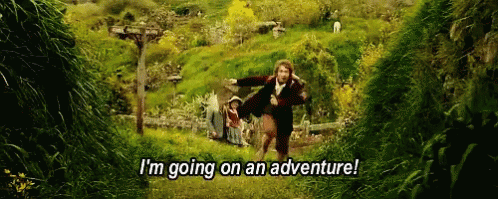
Act 1 - Promise
The first chapter is vital to letting your audience see your plot via promises. Readers expect promises to be kept. You need to be conscious and in control of your story’s promises.
The first few chapters should introduce plots and tone, but also make the audience understand the main characters.
Promises of
Tone: tone stays the same throughout
Character arc: something a character is missing in themselves will be found.
Plot: the story’s umbrella and core plots
Act 2: Progress
Progress is the most important part, and the hardest to do well, but it is 100% in your control.
A sense of progress is what makes readers keep turning the page. It can be in real-time, or as an illusion. Do not make progress irrelevant to the reader’s time.
This is where your plots should come close to their promises. Your arcs and promises generally should work together. Diversions or subplots can be stale due to not following the promises in some form.
At the end of Act 2, everything has broken down to their lowest points. Stakes were raised, but attempts to succeeded have failed terribly.
Act 3: Pay-Off
Act 3 is where new info, events, etc. make it possible to keep your promise. The last big decision, realizations, etc. all intersect.
Make good on your promises, or make the return on them even better. Ex. They don’t just win the bake-off, but a judge was so impressed with their journey that they get a cookbook deal and a steady job, too.
Sometimes a promise can be inverted. Ex. the protagonist realizes what they’ve chased the whole time isn’t what they need, and their need is a much better pay-off.
Brandon Sanderson’s free 2020 lectures on YT
18 notes
·
View notes
Text
Empathy. Motivation. Progress.
The secret to making your readers care about a character lies in these 3 sliding scales, according to Brandon Sanderson.
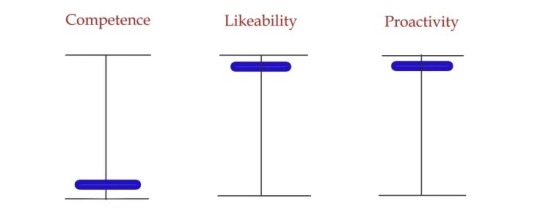
Show throughout the story the answers to the following bullets:
Empathy (likability)
How relatable are they?
Are they kind or sympathetic to others?
How do other characters treat them?
Motivation (proactivity)
Are the character’s motivations interesting?
Can the character have what they desire? Do they initially avoid what motivates them?
How do a character’s motivations conflict with their flaws, and/or tie to the plot?
What steps is the character taking to get what they want?
People have many things that motivate them. Sometimes they can never have something they desire, sometimes they don’t want the thing they actually need at first. Motivations can conflict with each other, the plot, and a character’s morality.
Progress (competence)
What flaws does the character need to face in order to progress?
Does the character overcome their flaws, fail, step around them, etc.?
Will the character fulfill their promise(s)?
Motivation and progress often go hand-in-hand. Progression should be hard, to keep characters in check.
These sliding scales work just as well for protagonists as they do for villains, and everyone else in between.
Remember, the scales shouldn’t be maxed out. A character perfect at all three sliding scales is difficult to care about, and your characters are your story’s lifeblood.
Brandon Sanderson’s free 2020 lectures on YT
200 notes
·
View notes
Text
Hey all, This is my first Tumblr post ever! I'm pretty new here, but I'm hoping to share some DM techniques, tools and tips and to make some new friends as well! Feel free to send a chat request (an ask[?]) if you're interested!
With that aside, on with the post!
Better and More Meaningful Random Encounters!
Random encounters are a staple of DnD, they are expected to be there during exploration as a way to make the world feel alive, to have it have an aura of adventure and danger, to eat up party resources and put pressure on the PCs to make interesting and important choices, and also as a way for a DM to reasonably 'stall' the party with a quick and easy situation.
Usually, it ends up something like this:
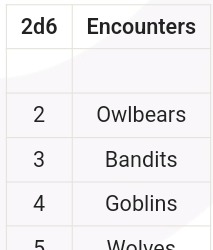
There's just one problem with most random encounter tables though, it's so easy for them to be GOSHDARN BORING! Especially for a newer DM.
Making them interesting becomes gambled improv on the DM's part if they're not used to it, and it's hard to keep track of the important factors that need to be kept in mind
Luckily, I ended up finding a great source for random encounters from 'Dungeon Masterpiece' on YouTube, and I integrated it into my own DMing. I figured that I'd share it here for any that want to work it into their own sessions as well!
After adjustment, a single table can account for multiple entire sessions of in-depth worldbuilding and fun without getting dull!
Sources:
Source 1 (Creating interesting Random Encounter Tables):
youtube
Source 2 (Making Random Encounters reflect your Worldbuilding):
youtube
There's 4 major methods we can use to improve the Random Encounter table
1. Make the table a straight 1dx roll.
2. Adding 'depth'.
3. Adding meaningful encounters.
4. Prerolling and/or Multirolling.
You can also check out the "Where to Start?" section for some direction to make getting it down and prepped all easy peasy!
1. Straight Roll:
Its enticing to go for 2d6 or the such in order to add non-linearity to the rolls, but these sorts of adjustments only end up making one or two encounters extremely likely and leave all others in the dust, it often ends up defeating it's own purpose of interesting randomness.
In the previous example, it was extremely likely to only get Wolves, Barbarians, Orcs, or Spiders, from a table of 12! A straight roll would serve us much better. The rare rolls are already rare enough as is!
Simply enough, adjusting the original example by replacing the 2d6 with 1d12, it'd become something more like this:
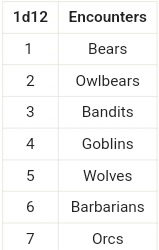
#2. Adding Depth:
We can add more columns in the encounter tables. These columns will represent different aspects about the encounters that we can roll on separately!
Usually it can be difficult as a DM to naturally come up with motives for the encounters, showcase the worldbuilding and have it all come together.
This setup can give you a solid guideline on how the creatures/people think (if any), and also sets up the overall area so that you get an idea of what events tend to occur there as a result of its occupants.
We want to add 3 more columns to the tables to convey different aspects of the encounter. Fill in these new columns corresponding to the expectations of each encounter.
We'll roll each of these and combine them, then we'll interpret them to make a robust, in-depth random encounter with truly unexpected results!
I recommend rolling alot of complete encounters at once and interpreting the context to the vast general area the party is travelling in.
i. Behaviour: How the creatures act. Are they friendly, scared, aggressive, curious, mischievous?
ii. Complication: Something behind the scenes in the encounter. Do they have sick young? Broken equipment? Are they starving?
iii. Significant Impact: This is a tick box, and will only be present under ONE of the rows. It will be rolled like the other columns, but ONLY once. It signifies which encounter is the Significant Encounter
The Significant Encounter will have its encounter's presence prominent amongst all the other random encounters in the area. There could be burn marks and carcasses from a rampant dragon, or a goblin raid leaving tracks moving through the area. Which is the most impactful of the different encounters?
Adding this to our previous example would expand it to:

Rolling this would give us things like:
Significant encounter: Owlbears

Note that the significant impact shows that the Owlbears are a massive problem in the area. Perhaps the Owlbears are agitated for an unknown reason, and are unnecessarily aggressive.
The significance of Owlbears gives us context to the second one as well! Perhaps the hunters raided an Owlbear den, and adopted an Owlbear cub from there as well.
There could be uneaten carcasses, ravaged trees, less wildlife, etc around these parts.
Note how much sheer CONTEXT these columns add to our encounters. It's invaluable!
3. Adding Meaningful Encounters
Usually random encounters tend to be rather mundane and very one-note.
There's usually some general wildlife and monsters, different disparate factions without any rhyme or reason, and maybe a general non-combat encounter or two, but these don't really tell us about the area or its surroundings at all by themselves.
Instead, we can add in wildlife and monster encounters specific to the biome, non-combat encounters, and encounters of nearby factions and/or settlements to the table, and we can even add environmental encounters in there as well.
Note that we're not tied down to 12 encounters, and can expand it ad infinitum according to our need of diversity in our encounters.
Just add in specification and connection, and suddenly the dominos all fall into place.
Lastly, we'll also be adding in 'DOUBLE TIME' which will let us roll on everything twice, and make it so it's a double encounter!
Thus, the table can instead be adjusted to:
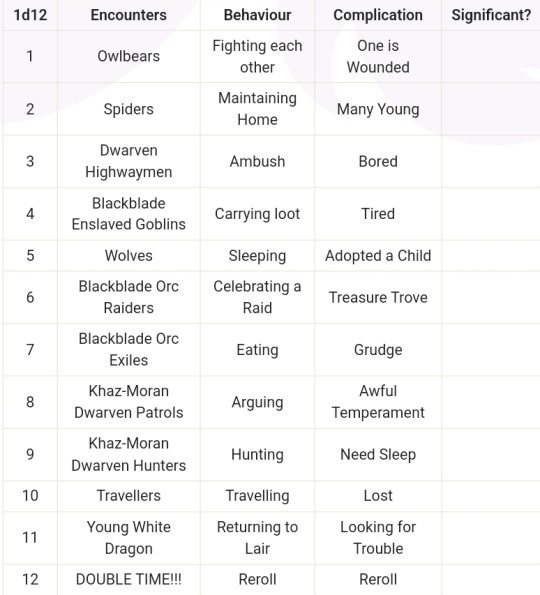
Note how each and everything has its relation in one way or another, but through the sheer variance, they remain truly random and novel.
4. Prerolling and/or Multirolling
Lastly and this is just something that I do, but that I found gamechanging. Be sure to pre-roll 5-7 encounters for each session, for the general area the players are going to be headed in.
Note that you don't need to really prep anything at all, just interpret all of them on a surface level as a buffer.
Also note that you don't need to use all of them if they're not needed. The foreshadowing and signs are worldbuilding and having secrets that the players don't unravel is just as useful as the ones that they do, perhaps even moreso. It adds depth and detail beyond the scope of what the party will encounter
It simply let's you get an idea of the connections between encounters, allows for foreshadowing, and acts as a deterrent to getting caught off guard.
Even if you roll mid-session, I recommend calling for a 5 minute break, rolling 5-7 encounters at the same time and interpreting them and their connections before resuming the session.
It WILL make a difference, trust me
Where to start?
It can be difficult getting inspiration or direction to get started in creating these random encounters, and sometimes you don't want to go through the hassle of thinking them up from nothing
For some great conceptual headstarts and examples for these tables, you can check out 'Worlds Without Number' and it's:
- Page 205 (Great general templates for encounters differentiated by broad creature types such as Beasts and Monsters, Sapient Monsters, and Humans)
- Pages 206-219 (For inspired locations to occasionally run rare encounters or groups of encounters in. This works best with flexible/discovered worldbuilding given the significance of some of these, and you also want to add these in sparingly to keep them significant)
- Pages 246-247 (These pages have great templates for the kinds of encounters and situation to be included in the tables, and it can be expanded vastly, and certain options can be selectively and repeatedly chosen to meet our needs. Mood works well as a complication.)
There might be other pages that are useful as well for these sorts of random encounters in the wilderness that I haven't come across yet. If so, give them a shout out and I'll be sure to add them in. It's worth checking it out in its entirety for some great tips!
Conclusion
Again, credit goes to Dungeon Masterpiece and Worlds Without Number for excellent adjustments. This has been quite long, but I hope you stuck around till the end.
Many a session have been made easy but complex ever since this was introduced and I hope that this helps you out as much as it helped me in my prep and improv!
Feel free to give any advice in formatting on Tumblr, or any feedback on the post itself. It really means a lot to me, thanks!
#dm tools#dungeons and dragons tips#dungeon master tips#dm advice#dm tips#ttrpg#dnd#Youtube#dnd resources#gm tips
58 notes
·
View notes